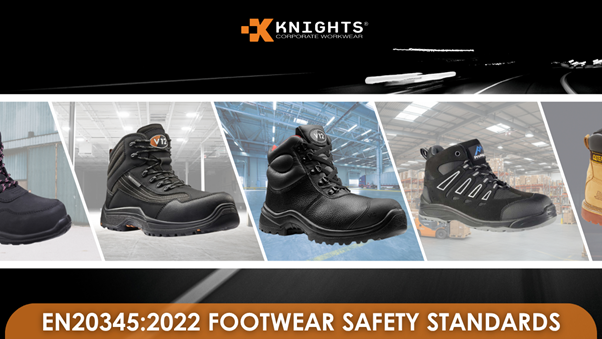EN ISO 20345:2022 - What Buyers Need to Know About the New Safety Footwear Standard
Oct 9 2025 10:02AM

Safety footwear is one of the most visible and important items of PPE on any site. In 2022, the safety footwear standard EN ISO 20345 was updated, introducing several significant changes to testing, markings, and optional performance classes. For purchasing managers, safety officers, and specifiers, understanding these changes will help you select boots that truly protect your people and meet the demands of the modern workplace.
Below, we explain the practical differences introduced by EN ISO 20345:2022, why they matter, and how Knights can help you choose the right footwear for your operation.
**DOWNLOAD OUR SAFETY STANDARD GUIDE HERE**
What’s changed - the headline points
The 2022 revision refines several existing requirements and introduces clearer, more specific markings and optional performance features. The most important practical changes are:
- Slip resistance is now a basic requirement, with a standard ceramic + detergent test forming the baseline for all certified safety footwear. Additionally, tougher slip tests (for oily floors) may be recorded as an extra feature (marked SR).
- Puncture (penetration) markings are more specific. Where the old standard used a single “P” marking, the new standard distinguishes non-metallic inserts tested with different nail diameters (PS for small, PL for large) while metallic inserts retain the traditional P designation. This helps you match footwear to actual puncture risks.
- Water resistance requirements have been tightened. The updated definitions and test outcomes mean water-resistant markings are more stringent than before - fewer products will meet the higher WR threshold without careful design and testing.
- New additional feature markings (for example, SR, SC for scuff cap abrasion resistance, and LG for ladder grip) are available to show enhanced performance in specific tasks or environments. These additional features are optional but useful when assessing footwear for niche risks.
- New protection classes and clarifications (some markets and manufacturers also reference extended categories such as S6/S7 for constructions and properties) make it easier to identify boots built for wet environments or specific tasks. Note: legacy products to EN ISO 20345:2011 remain valid while stocks last, but newer models will increasingly carry the 2022 markings.
Why these changes matter in practice
- Better match between risk and protection
The more granular puncture markings (PS/PL) let you choose footwear whose tested resistance aligns with the actual hazards on your site - for example, construction zones with small-diameter nails vs. heavy vehicle yards where larger sharp objects are a risk. - Slip performance is standardised
Slip resistance used to be split into SRA, SRB and SRC classifications. Under the 2022 standard, a baseline slip test is mandatory for all safety footwear, improving the minimum standard expected across the board. If your workplace involves oily surfaces, look for the SR additional marking that indicates extra tests on oil-contaminated surfaces. - More honest water-performance claims
The reworked water resistance tests mean suppliers can no longer use the same WRU/WR claims without demonstrating performance to the stricter pass criteria. That matters for site teams who work in prolonged wet conditions - poor water resistance incrWhat to ask your supplier
When specifying or buying to the 2022 standard, ask these practical questions:- Which standard is the boot certified to? (EN ISO 20345:2022 or earlier)
- What puncture class does the boot have? (P, PL, PS) - useful for matching risk.
- Does the boot meet the SR additional test (oil/grease resistance) or just the baseline slip test?
- What water resistance marking is claimed, and do test reports support it?
- Are there any other additional features (SC, LG, FO) relevant to our work environment?
Requesting this information - ideally as part of product data sheets or a Declaration of Conformity - will prevent surprises in service, warranty claims and worker dissatisfaction.
Implementation: what this means for existing fleets
You do not need to withdraw all EN ISO 20345:2011 boots from service immediately. Certified stock produced under the old standard can still be sold and used. However, if you are specifying new purchases, it’s wise to move to EN ISO 20345:2022-certified footwear for clearer, enhanced protection and up-to-date testing. Over time, as old stock depletes, the market will naturally shift to the 2022 markings.Choosing the right boot - a practical checklist
- Clarify the primary hazards (impact, compression, puncture, slip, hydrocarbons, ladder work, prolonged wet conditions).
- Match markings to risks (PS/PL for puncture, SR for oily slips, FO for fuel/oil resistance).
- Confirm fit and comfort - even the best-performing boot fails if it isn’t worn correctly.
- Check test documentation - ask for the test reports or the notified body certificate if needed.
- Plan rotating replacements - phase in 2022-rated footwear during normal replacement cycles for budgetary control.
At Knights Corporate Workwear, we can help you interpret the markings, compare models, and select footwear that matches your hazards and budget. Whether you need boots with enhanced puncture protection, oil-resistant soles, or proven waterproof performance, our product specialists will guide you to the most appropriate choices and supply the necessary conformity documentation.
📞Contact us today to review your safety footwear policy or arrange a site consultation.
📧sales@knightsuk.com | 🌐 https://www.knightsuk.com/contact-us
